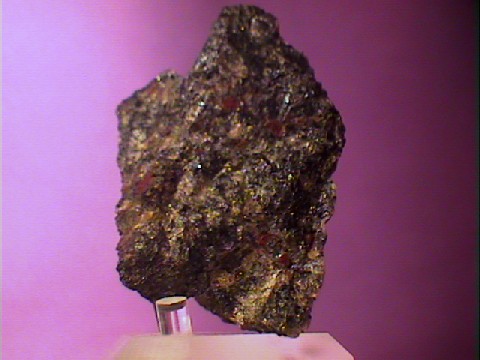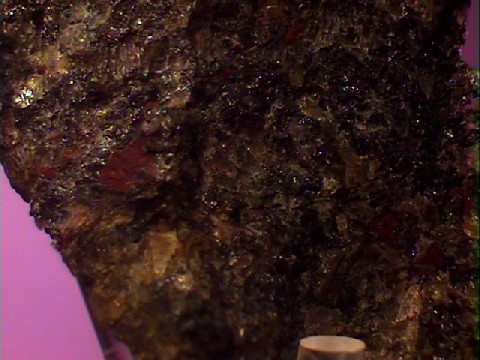 THE
MINERAL SYNCHYSITE
THE
MINERAL SYNCHYSITE
- Chemistry: Ca(Ce, La, Nd, Y)(CO3)2F , Calcium Cerium Lanthanum Neodymium Yttrium Carbonate Fluoride.
- Class: Carbonates
- Groups: Rare earth carbonates and Bastnasite.
- Uses: As a minor ore of cerium and other rare earth metals and as mineral specimens.
Specimens
Synchysite is one of a few rare earth carbonate minerals.
Some of the other more common rare earth carbonates are
Synchysite has cerium, neodymium, lanthanum and yttrium in its generalized formula but officially the mineral is divided into three minerals based on the respective predominant rare earth element. There is synchysite-(Ce) with a more accurate formula of Ca(Ce, La)(CO3)2F. There is also synchysite-(Nd) with a formula of Ca(Nd, La)(CO3)2F. And finally there is the very rare synchysite-(Y) with a formula of Ca(Y, Ce)(CO3)2F. There is little difference in the three in terms of physical properties and most synchysite is synchysite-(Ce).
Synchysite is closely related to three other distinct minerals;
parisite,
bastnasite
and
Synchysite was first discovered in the alkali- and hyperalkali-pegmatitic syenites of Narsarsuk, Greenland. Samples were originally described as parisite until the two minerals were conclusively separated in 1953 along with the establishment of bastnasite and rontgenite as distinct species as well. Synchysite's name is loosely derived from the Greek as "co-fluid" possibly alluding to these closely intermingled minerals.
As mineral specimens, synchysite has a wonderful crystal habit, nice luster and interesting color. Although usually the crystals are small and make excellent micromount specimens, they are generally well developed especially in specimens from Mont Saint-Hilaire. Their typical crystal habit is pseudohexagonal prisms that taper to a point or are bluntly terminated by a flat pinacoid face. The tendancy to thin and then widen repeatedly within the same crystal often yields a crystal shape that reminds one of an accordian. Weloganite is another carbonate mineral with a very similar crystal habit.
PHYSICAL CHARACTERISTICS:
- Color is yellow, brown, yellow-orange, amber, pale green and white.
- Luster is vitreous, greasy to dull.
- Transparency: Crystals are translucent to opaque.
- Crystal System is monoclinic (but pseudohexagonal).
- Crystal Habits include small pseudohexagonal prismatic crystals that can taper in and out giving an accordion like look. Tabular or platy crystals are also seen as well as in rosettes, spheres and subhedral grains.
- Cleavage is fair in one direction (basal).
- Fracture is subconchoidal to splintery.
- Hardness is 4 to 4.5.
- Specific Gravity is 3.9 to 4.0 (above average)
- Streak is white to yellowish white.
- Other Characteristics: Easily soluble in nitric acid and crystals are striated parallel to the basal face.
- Associated Minerals are extensive and include
fluorite,
galena,
aegirine,
albite,
hematite,
zircon,
pyrochlore,
astrophyllite,
quartz,
parisite,
magnetite,
anatase,
smithsonite,
rutile,
siderite,
cerussite,
riebeckite,
bastnasite,
rontgenite-(Ce) , ankerite, calcite, carbocernaite, cordylite, dolomite, strontianite,sahamalite-(Ce) , apatite, chlorite, biotite, catapleiite, sphalerite, barite, monazite and xenotime. - Notable Occurrences include the type locality of
Narsarsuk , Greenland. Other localities include the Clara Mine, Germany; Kola Peninsula, Russia; the mines of Mont Saint-Hilaire and at Gatineau, Quebec and the Thor Lake deposits, Northwest Territories, Canada; Cuasso al Monte, Italy; Adiounedj, Mali;langesundsfjord area, Norway; the Baerzhe deposit, Daxinganling Mountains, China; various karst bauxite sites in the Balkans especially at Grebnik Mountain, Serbia which is the type locality for synchysite-(Nd) and Scrub Oaks Mine, Dover, New Jersey, USA which is the type locality for synchysite-(Y). - Best Field Indicators: crystal habit, color, cleavage, density, luster, solubility in nitric acid and locality.



